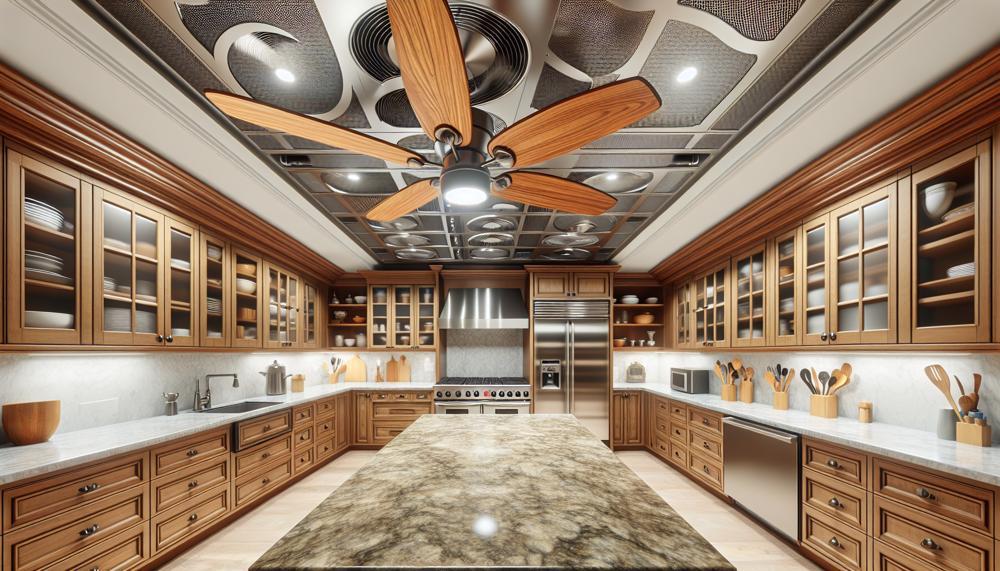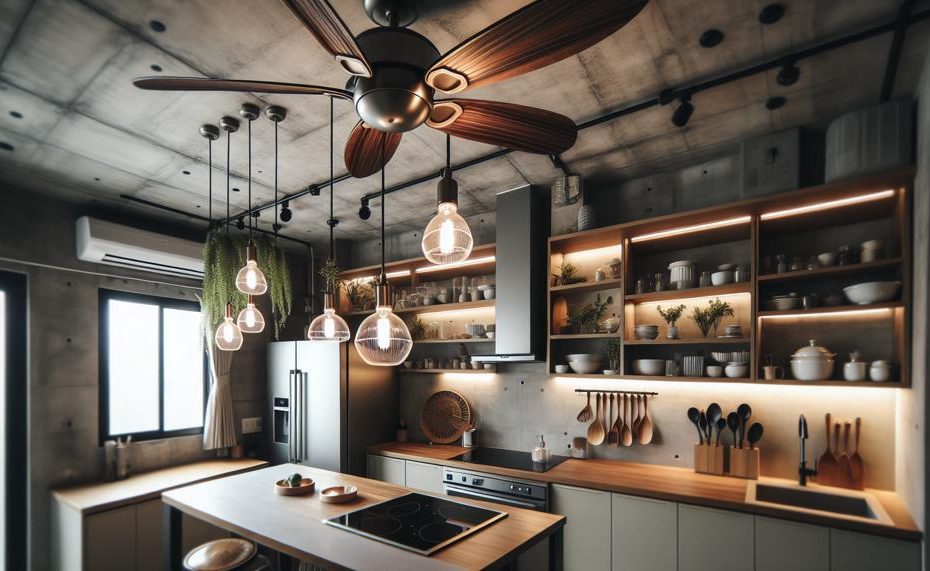Are ceiling fans in kitchens a thing of the past? It’s a question that has sparked heated discussions among homeowners and interior designers for years.
Some claim that these spinning fixtures are outdated and should be replaced with more modern options, while others argue that they still serve a functional purpose in kitchen spaces.
In this blog post, we’ll delve into the debate and explore the relevance of ceiling fans in today’s kitchens.
So, are ceiling fans in kitchens outdated?
No, ceiling fans are not outdated. They are still popular because they are energy efficient, cost effective, and have a lower environmental impact than air conditioners. They can also help regulate indoor temperature year-round. Ceiling fans can also improve air circulation, save energy, and enhance ventilation. When chosen thoughtfully and installed correctly, a ceiling fan can be both a practical and aesthetic asset to your kitchen.
Contents
Why did ceiling fans become popular?
The increasing popularity of ceiling fans in kitchen spaces can be attributed to various key factors:
- Energy efficiency and affordability: With the growing demand for environmentally-friendly and budget-conscious solutions, ceiling fans have emerged as a top choice for cooling and air circulation in homes. They consume less energy compared to air conditioning units, making them a practical and cost-effective option.
- Technological advancements: The development of more efficient and versatile ceiling fan models, such as those with remote controls and LED lighting, has made them a convenient choice for homeowners. This has also led to a wider range of designs and styles available in the market.
- Versatility and functionality: Kitchens are multifunctional spaces, and ceiling fans provide an excellent solution for proper air circulation and ventilation. They can also be used during colder months to push warm air downwards, making them a practical choice year-round.
- Easy installation: Unlike other cooling options that may require professional installation, most ceiling fan models come with easy-to-follow instructions for DIY installation. This makes it a popular choice for homeowners looking to update their kitchen space without breaking the bank on installation costs.
- Eco-friendly and sustainable living: As more people prioritize environmentally-conscious living, there is a growing demand for energy-efficient and sustainable home solutions. Ceiling fans not only consume less energy but also help reduce the need for air conditioning, contributing to reducing carbon emissions.
Are ceiling fans a thing of the past?
The answer is no. In fact, they are still highly relevant and functional in modern kitchens. These versatile fans offer numerous benefits, such as energy efficiency and easy installation.
With advancements in technology, there is a wide selection of designs to choose from that can enhance the overall aesthetic of a contemporary kitchen.
However, it is crucial to select the right type of ceiling fan that perfectly fits the size and style of your kitchen to avoid making it appear outdated or unnecessary.
Reasons to install ceiling fans
Installing ceiling fans in kitchens offers a multitude of benefits, including improved air circulation, better ventilation, energy efficiency, decorative appeal, lighting functionality, and potential increase in home value.
Homeowners should highly consider incorporating ceiling fans into their kitchen design due to the practical and aesthetic advantages they provide. Despite concerns about their outdated appearance, there are a variety of styles and designs available that can seamlessly complement any kitchen theme.
Moreover, ceiling fans offer a cost-effective way to cool and ventilate the kitchen, resulting in reduced energy costs.
They also serve as an additional source of light in the kitchen. Not to mention, they can potentially increase the overall value of a home.
What do interior designers say about ceiling fans?
A major consideration for interior designers is the purpose of the ceiling fan. Its main function should be to circulate air and provide ventilation, rather than being purely decorative or equipped with a light. This means that the design and style of the fan should blend seamlessly into the background and not be overly attention-grabbing unless purposely chosen for that effect.
When selecting the appropriate size and speed for a ceiling fan, interior designers prioritize its effectiveness in moving air over its physical size or CFM rating. This means that for higher ceilings, a down rod stem may be necessary to bring the breeze closer to where it’s needed, but this can also result in more noise and vibration at higher speeds.
While some may argue that ceiling fans are outdated in kitchens, they can still serve a purpose and add charm in certain situations. For instance, they can be a great addition on porches or in homes without air conditioning.
Additionally, many interior designers tend to stick to classic styles when incorporating ceiling fans into kitchen designs
What makes a ceiling fan fashionable?
Integrating a ceiling fan into your kitchen can elevate its overall style and design, offering not only functionality and versatility but also visual interest, cost-effectiveness, and practical benefits.
Ceiling fans efficiently circulate air, cooling down the room and creating a more comfortable environment for cooking and entertaining. With a wide variety of styles and designs available, homeowners can select the one that best complements their kitchen’s aesthetic.
A ceiling fan also serves as a striking element in the space, serving as a focal point and breaking up the mundane sight of cabinets and appliances. Furthermore, these fans are eco-friendly and budget-friendly, consuming less energy than air conditioning units.
They also come equipped with built-in lights and remote controls for added convenience.

Top Considerations When Choosing a Ceiling Fan
When it comes to choosing a ceiling fan for your kitchen, there are numerous factors that must be taken into account in order to determine if they are still considered outdated.
These considerations include cost-effectiveness, flexibility, potential for noise and drafts, upkeep, historical significance, advantages compared to contemporary cooling methods, appropriate size and installation, the development of ceiling fan technology over time, personal interior design preferences, and safety measures.
Conclusion
As our conversation draws to a close, it is evident that homeowners and interior designers continue to have intense disagreements over the use of ceiling fans in kitchens.
Some contend for their usefulness, while others express worries about any possible negative effects. But given the state of technology today and the wide range of fashionable styles that are available, ceiling fans are clearly far from being outmoded.
In addition to increasing energy efficiency and air circulation, they also make a statement in contemporary kitchen designs. In the end, practicality and personal taste should guide your choice to install a ceiling fan in your kitchen.





